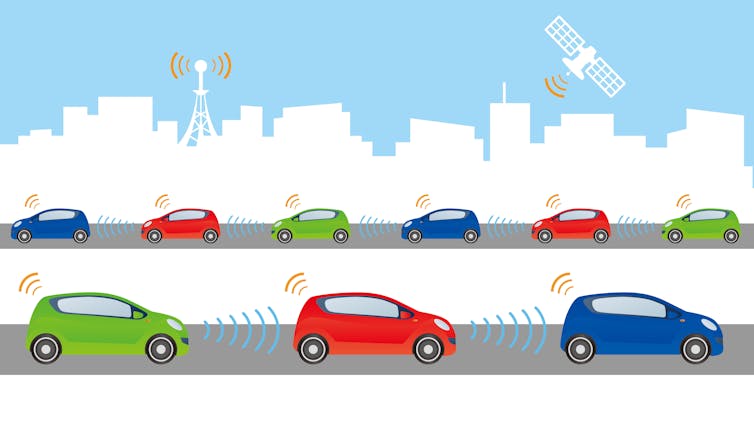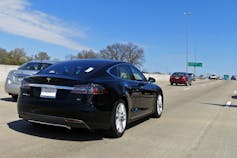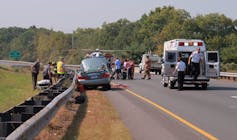Saving lives by letting cars talk to each other – CWEB.com

Connected cars graphic via shutterstock.com
Huei Peng, University of Michigan
The death of a person earlier this year while driving with Autopilot in a Tesla sedan, along with news of more crashes involving Teslas operating in Autopilot, has triggered a torrent of concerns about the safety of self-driving cars.
But there is a way to improve safety across a rapidly evolving range of advanced mobility technologies and vehicles — from semi-autonomous driver assist features like Tesla’s Autopilot to a fully autonomous self-driving car like Google’s.

pasa47, CC BY
The answer is connectivity: wireless communication that connects vehicles to each other, to the surrounding infrastructure, even to bicyclists and pedestrians. While connectivity and automation each provide benefits on their own, combining them promises to transform the movement of people and goods more than either could alone, and to do so safely. The U.S. Department of Transportation may propose requiring all new cars to have vehicle-to-vehicle communication, known as V2V, as early as this fall.
Tesla blamed the fatal crash on the failure of both its Autopilot technology and the driver to see the white tractor-trailer against a bright sky. But the crash — and the death — might have been avoided entirely if the Tesla and the tractor-trailer it hit had been able to talk to each other.
Limitations of vehicles that are not connected
Autonomous vehicles that aren’t connected to each other is a bit like gathering together the smartest people in the world but not letting them talk to each other. Connectivity enables smart decisions by individual drivers, by self-driving vehicles and at every level of automation in between.
Despite all the safety advances in recent decades, there are still more than 30,000 traffic deaths every year in the United States, and the number may be on the rise. After years of steady declines, fatalities rose 7.2 percent in 2015 to 35,092, up from 32,744 in 2014, representing the largest percentage increase in nearly 50 years, according to the U.S. DOT.

Ragesoss, CC BY-SA
The federal government estimates that 94 percent of all crashes — fatal or not — involve human error. Fully automated, self-driving vehicles are considered perhaps the best way to reduce or eliminate traffic deaths by taking human error out of the equation. The benefits of automation are evident today in vehicles that can steer you back into your lane if you start to drift or brake automatically when another driver cuts you off.
A self-driving vehicle takes automation to a higher level. It acts independently, using sensors such as cameras and radars, along with decision-making software and control features, to “see” its environment and respond, just as a human driver would.
However, onboard sensors, no matter how sophisticated, have limitations. Like humans, they see only what is in their line of sight, and they can be hampered by poor weather conditions.
Connecting cars to each other
Connected vehicles anonymously and securely “talk” to each other and to the surrounding infrastructure via wireless communication similar to Wi-Fi, known as Dedicated Short Range Communications, or DSRC. Vehicles exchange data — including location, speed and direction — 10 times per second through messages that can be securely transmitted at least 1,000 feet in any direction, and through barriers such as heavy snow or fog. Bicycles and pedestrians can be linked using portable devices such as smartphones or tablets, so drivers know they are nearby.
The federal government estimates that V2V connectivity could ultimately prevent or reduce the severity of about 80 percent of collisions that don’t involve a driver impaired by drugs or alcohol.
Cars are already connected in many ways. Think satellite-based GPS navigation, in-vehicle Wi-Fi hotspots and smartphone apps that remind you where you parked or remotely unlock your doors. But when it comes to connectivity for safety, there is broad agreement within the auto industry that DSRC-based V2V communication holds the most potential for reducing crashes. After years of testing, the industry is poised to roll out the technology. The next step is putting regulations in place.

joiseyshowaa/flickr, CC BY-SA
Perhaps the greatest benefit of connectivity is that it can transform a group of independent vehicles sharing a road into a cohesive traffic system that can exchange critical information about road and traffic conditions in real time. If all vehicles are connected, and a car slips on some ice in blinding snow, vehicles following that car — whether immediately behind or three or four or more vehicles back — will get warnings to slow down. A potential 100-car pileup could become a two-car fender-bender, or be avoided altogether.
This technological shift becomes a revolution when connectivity and automation are combined. A self-driving vehicle is like an island on the road, aware only of what is immediately around it. Connectivity empowers a driverless car. It alerts the vehicle to imminent dangers it may not otherwise sense, such as a vehicle about to run a red light, approaching from the other side of a hill or coming around a blind corner. The additional information could be what triggers an automated response that avoids a crash. In that way, connectivity enables more, and potentially better, automation.
More research needed
At the University of Michigan Mobility Transformation Center, we’re working to further the development of connected and automated vehicles.
Advanced mobility vehicle technology is evolving rapidly on many fronts. More work must be done to determine how best to feed data gathered from sensors to in-vehicle warning systems. We need to more fully understand how to fuse information from connectivity and onboard sensors effectively, under a wide variety of driving scenarios. And we must perfect artificial intelligence, the brains behind self-driving cars.
The benefits of connected and automated vehicles go well beyond safety. They hold the potential to significantly reduce fuel use and carbon emissions through more efficient traffic flow. No more idling at red lights or in rush hour jams for commuters or freight haulers.
Connected self-driving cars also promise to bring safe mobility to those who don’t have cars, don’t want cars or cannot drive due to age or illness. Everything from daily living supplies to health care could be delivered to populations without access to transportation.
[youtube https://www.youtube.com/watch?v=9TXBP1t2rUc&w=560&h=315]
![]() Researchers at MTC are also studying possible negative unintended consequences of the new technology and watching for possible privacy violations, cyberattack vulnerabilities or increases in mileage driven. Deeper understanding of both technology and social science issues is the only way to ensure that connected self-driving cars become part of our sustainable future.
Researchers at MTC are also studying possible negative unintended consequences of the new technology and watching for possible privacy violations, cyberattack vulnerabilities or increases in mileage driven. Deeper understanding of both technology and social science issues is the only way to ensure that connected self-driving cars become part of our sustainable future.
Huei Peng, Professor of Mechanical Engineering, University of Michigan
This article was originally published on The Conversation.

